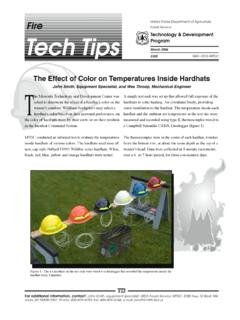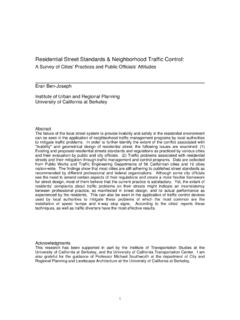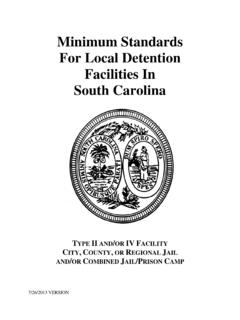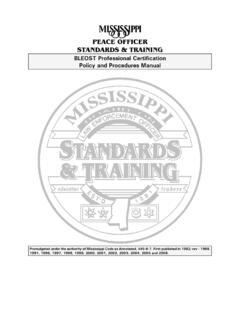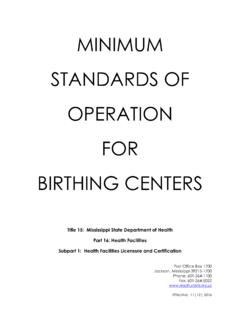Transcription of Interim NWCG Minimum Standards for Medical Units …
1 January 7, 2010 Interim nwcg Minimum Standards for Medical Units Managed By nwcg Member Agencies nwcg Safety and Health Working Team Incident Emergency Medical Task Group 2 January 7, 2010 To: nwcg member agencies, GACCs, IMTs and Medical unit leaders After years of hard work and effort put forth by representatives from nwcg member agencies, the National Association of EMS Officials (NASEMSO), the National Association of EMS Physicians (NAEMSP), numerous outside organizations, and from individual Medical unit leaders The Interim nwcg Minimum Standards for Medical Units has been published. This document reflects a national approach focused on providing a coordinated, uniformed, and comprehensive delivery of emergency Medical services (EMS) and occupational health on Federal wildland fires in the United States of America. The Interim nwcg Minimum Standards for Medical Units is designed to be utilized as a baseline or Minimum expectations for EMS personnel and services associated with Federal wildland fire incidents.
2 However, Medical directors of various programs and agencies may identify alternative Standards for use within their jurisdictional purview, therefore if questions or discrepancies are found, consult the appropriate Medical director or state EMS authority. Annually or when deemed appropriate, the nwcg will update the Interim nwcg Minimum Standards for Medical Units procedures, guidelines, supplies and equipment identified within this document. Any changes shall be channeled through the nwcg and posted on the Safety and Health Working Team (SHWT) Incident Emergency Medical Task Group s (IEMTG) web page located at: Due to continual updating of the document, for those utilizing a hard copy, it is strongly recommended to ensure it is the latest version by referencing the IEMTG website listed above. 3 January 7, 2010 Table of Contents Executive Summary.
3 7 Introduction ..8 Background ..9 Medical Scope of Practice ..9 Commonly Available Medications, Interventions and Supplies ..10 nwcg Wildland Fire Scope of Practice ..11 Personnel Credentials ..11 State EMS Authority Notification ..12 Medical Direction ..12 Communications ..13 Incident Patient Transportation ..13 Equipment and Supplies ..13 Implementation of Minimum Standards for Medical Units ..14 Appendices Appendix A .. National EMS Scope of Practice Model Skill Synopsis Appendix B .. nwcg Limited Request for Recognition Appendix C .. Recommended Equipment and Supply List 4 January 7, 2010 Definitions Advanced EMT (AEMT) An Emergency Medical Services (EMS) professional who provides basic and limited advanced life support skills and interventions for patients within an EMS system. Advanced Life Support (ALS) Emergency Medical care and interventions performed by an Advanced Emergency Medical Technician (EMT) or Paramedic with limited supervision, using critical thinking and autonomous decision making skills which includes invasive procedures and medication administration.
4 Basic Life Support (BLS) Emergency Medical care and interventions performed by an Emergency Medical Technician (EMT) with minimal equipment, limited medications and non-invasive procedures. Certification The issuing of certificates by an agency based upon Standards adopted by that agency that are usually based upon Minimum competence. Competency certification does not constitute permission to practice. Emergency Medical System A network of services coordinated to provide aid and Medical assistance from primary response to definitive care, involving personnel trained in the rescue, stabilization, transportation, and advanced treatment of traumatic or Medical emergencies. Linked by a communication system that operates on both a local and a regional level, EMS is a tiered system of care, which is usually initiated by citizen action in the form of a telephone call to an emergency number.
5 Subsequent stages include the emergency Medical dispatch, first Medical responder, ambulance personnel, medium and heavy rescue equipment, and paramedic Units , if necessary. In the hospital, service is provided by emergency department nurses, emergency department physicians, specialists, and critical care nurses and physicians. Emergency Medical Technician (EMT) An EMS professional who provides basic life support skills and interventions for patients within an EMS system. Expanded Role Skills and interventions not included in the National EMS Scope of Practice Model necessary for EMS professionals functioning in health care settings other than the typical prehospital setting including, but not limited to, wildland fire Medical Units . Incident Command System (ICS) A combination of facilities, equipment, personnel, procedures and communications operating within a common organizational structure, with responsibility for the management of assigned resources to effectively accomplish stated objectives pertaining to an incident.
6 Licensed Physician A physician licensed by or exempted from licensure by a state Board of Medicine to practice medicine or surgery in that state. 5 January 7, 2010 Licensure The act of a State granting an entity permission to do something that the entity could not legally do without such permission. Licensing is generally viewed by legislative bodies as a regulatory effort to protect the public from potential harm. A license is generally considered a privilege and not a right. Medical Advisor A physician or other health care professional used as a subject matter expert. Medical Director A physician responsible for the overall Medical care provided in the field. Medical Kit The generic term applying to NFES 1760, NFES 1835 and/or the sub-kits associated with NFES 1835. Medical Unit The ICS unit that is responsible for the emergency Medical and occupational health care of incident personnel.
7 Medical Unit Leader(MEDL) The ICS position responsible for supervising the Medical Unit and assigned Medical Unit personnel. Medical Unit Personnel Personnel assigned to function under the direction of the Medical Unit Leader. National Association of State EMS Officials (NASEMSO) The lead organization for developing national EMS policy and oversight, providing vision, leadership and resources for the improvement of state, regional and local EMS and emergency care systems. National EMS Scope of Practice Model The National EMS Scope of Practice Model published by the National Highway Traffic Safety Administration defines and describes four EMS licensure levels: Emergency Medical Responder (EMR), Emergency Medical Technician (EMT), Advanced EMT (AEMT), and Paramedic. Each level represents a unique role, set of skills, and knowledge base.
8 National Registry of Emergency Medical Technicians (NREMT) An organization that ensures graduates of EMS educational programs have met minimal Standards by measuring competency through a uniform testing process. On-Line Medical Direction The physician or designee on the radio or phone who gives real time Medical direction to the out-of-hospital providers. Over-the-Counter (OTC) Medications Drugs that can be purchased without a prescription. Paramedic An EMS professional who provides basic and advanced life support skills and interventions for patients within an EMS system. 6 January 7, 2010 Scope of Practice A predefined set of skills, interventions or other activities that an EMS professional is legally authorized to perform when necessary, usually set by state law or regulation and local Medical direction. Standard of Care Conduct exercising the degree of care, skill, and judgment that would be expected under like or similar circumstances by a similarly educated, reasonable EMS professional.
9 7 January 7, 2010 Executive Summary This document introduces stakeholders to the Minimum Standards developed by the Incident Emergency Medical Task Group (IEMTG) when a Medical Unit has been established by a National Wildfire Coordinating Group ( nwcg ) member agency. This document is intended to provide direction regarding Medical personnel and equipment assigned to the Medical Unit. The IEMTG recognizes the National EMS Scope of Practice Model as the baseline standard for emergency Medical service providers. Therefore, a key component of the Minimum Standards addresses the recognition of local, state, federal, and tribal jurisdictional authorities and the integration of Medical services. Overall, the Minimum Standards seek to ensure that incident personnel receive quality, timely Medical care on wildland fire incidents, which often occur in remote areas.
10 These Minimum Standards support the following goals of the IEMTG: Facilitate the national mobility and availability of EMS personnel for wildland fire incidents. Establish a scope of practice and promote a standard of care for Medical personnel assigned to a Medical Unit on a wildland fire incident. Provide national wildland fire emergency Medical and occupational health Standards to ensure the health and safety of incident personnel in an efficient and cost effective manner on wildland fire incidents. Minimize negative impact on local emergency Medical service resources, clinics and hospitals. Identify skills and medications needed on wildland fire incidents. Provide guidelines for appropriate emergency Medical service personnel and equipment to properly staff incidents. The IEMTG will continue efforts to address companion documents for other components of Medical operations for wildland fire incidents to include, but not limited to: Development of nwcg Wildland Fire EMS Protocols.







